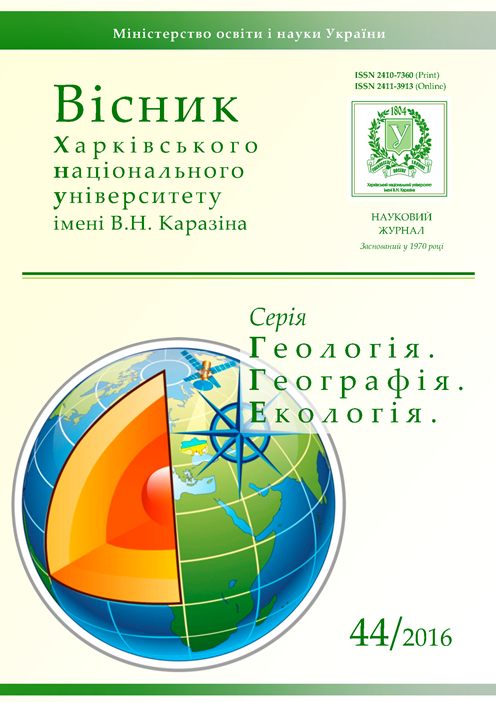Критерії розміщення нафтових та газових покладів у Дніпровсько-Донецькій западині з урахуванням соляної тектоніки
Анотація
Нафта і газ накопичуються в пастках під час руху через товщі осадових порід, як способом фільтрації в ущільнених породах та колекторах, так і способом струменевої їх міграції в зонах розущільнення та тріщинуватості порід у місцях активних тектонічних порушень та соляних діапірів. Розглянуто варіанти ймовірної, міграції та можливість генерації вуглеводнів у осадових товщах порід на шляху до місць своєї акумуляції в різноманітних пастках, а також швидкість фільтрації нафти і газу в різних умовах. Визначено часовий інтервал утворення вуглеводнів, який показує, що всі поклади вуглеводнів належать до недавнього, у геологічному обліку, часу накопичення. Визначені критерії для розподілу покладів нафти і газу як по розрізу так і по латералі в умовах Дніпровсько-Донецької западини.
Завантаження
Посилання
2. Makoveckiy, P.S. (1966). Geologicheskaya characteristic neftey i drugich bitumov Ukrainy i Moldavii [Geological description of oils and other bitumens of Ukraine and Moldavia]. Nedra, 301.
3. Rozanov, L.N. (1962). Teoreticheskie voprosy neftyanoy geologii [the Theoretical questions of oil geology]. Publishing house AN UKRAINE, – 108.
4. Sokolov, V.A. (1965). Processy obrazovaniya i migracii nefti I gaza [Processes of education and migration of oil and gas]. Nedra, – 276.
5. Chekalyuk, E.B. (1967). Neft verkhney mantii Zemli [Oil of overhead mantle of Earth]. Naukova dumka, 256.
6. Chekalyuk, E.B. (1983). Obschaya teoriya proiskhozhdeniya nefti [the General theory of origin of oil] Geology and geochemistry of combustible minerals. Naukova dumka, 59, 3-7.
7. Lur'e M.A. (2012). Neft'. K of diskussii oh proiskhozhdenii. Serosoderzhanie of I metallonosnost' kak of geneticheskie description [Lur'e M.A. Oil. To the discussion about an origin. Serosoderzhanie and metalliferousness as genetic descriptions] Saarbrucken. : LAP Lambert Academic Publishing, 243.
8. Zavyalov, V.M. (1970). Pro verticalnu zonalnist rozpodilu skupchen nafti i gasa v osadochnom chohli zemnoї cory [About the vertical zonality of distributing of accumulations of oil and gas in the cover of sinking of the earth's crust] Geology and geochemistry of combustible minerals. Naukova dumka, 22, 6-10.
9. Zavyalov, V.M. (1971). Pro osoblyvosti prostorovogo rozmischennya pokladiv nafti i gasa v Dniprovsko-Donetskoy vpadine [About the features of the spatial placing of beds of oil and gas in to Dnepr-Donetsk to zapadini]. Geology and geochemistry of combustible minerals. Naukova dumka, 28, 3-8.
10. Korzhov, Y.V., Isaev, V.I., Korzhov, Y.V., Zhilcova, A.A. (2011). Problemy neftepoiskovoy geokhimii i obobschayuschaya schema migracii uglevodorodnykh flyuidov [Problems of neftepoiskovoy geochemistry and summarizing chart of migration of hydrocarbon flyuidov] News of the Tomsk polytechnic university, 318/1, 116-122.
11. Lur’e, A.I. (2011). O principach sosuschestvovaniya gidrodinamicheskikh i geotemperaturnykh anomaliy v neftegazonosnykh provinciyakh [About principles of coexistence of hydrodynamic and geotemperature anomalies in oil-and-gas bearings provinces]. Announcer of the Kharkiv national university. Series: «Geology-geography-ecology», 956, 38-42.
12. Lur'e, A.I. (1987) Role of geotermicheskikh anomaliy mestorozhdeniy uglevodorodov for ocenki neftegazonosnosti [Role of geothermal anomalies of deposits of hydrocarbons for the estimation of the oil-and-gas bearing]. VNIIEgazprom, 8, 50.
13. Vysockiy I.V., Vysockiy V.I. (1986). Formirovanie of neftyanykh, gazovykh I kondensatnogazovykh mestorozhdeniy [Forming of oil, gas and kondensatnogazovykh deposits]. Nedra, 228.
14. Dyunin, V.I., Korzun, A.V. (2005). Gidrogeodinamika neftegazonosnykh basseynov [Gidrogeodinamika of oil-and-gas bearings pools]. Nauchnyy mir, 524.
15. Hunt, J.M., Keith, P.Ph., Kvenvolden, A. (2002). Early developments inpetroleum geochemistry. Organic Geochemistry, 33, 1025-1052.
16. Bushnev, D.A., Burdel'naya, N.S., Valyaeva, O.V., Savel'ev, V.S. (2005). Produkty termotransformacii kerogena goryuchego slanca v usloviyakh protochnogo piroliza v srede benzola [Products of termotransformacii of kerogen of pyroshale in the conditions of running pyrolysis in the environment of benzol]. Geochemistry, 11, 1238-1245.
17. Larin, V.I. (2007) Obrazovanie i intensivnost formirovaniya zalezhey nefti i gaza [Education and intensity of forming of beds of oil and gas]. Geology, geophysics and development of oil and gas deposits, 3, 54-59.
18. Trofimov, V.A. (2008). Glubinnye seysmicheskie issledovaniya MOGT kak instrument ocenki perspectyv neftegazonosnosti i poiskov krupnykh skoplenyi uglevodorodov [Deep seismic researches of MOGT as instrument of estimation of prospects of the oil-and-gas bearing and searches of large accumulations of hydrocarbons]. Geology of oil and gas, 4, 55-63.
19. Neruchev, S.G. (1998). Spravochnik po geokhimii nefti i gaza [Reference book on geochemistry of oil and gas]. Nedra, 576.
20. Bazhenova O.K., Burlin Yu.K., Sokolov B.A., Khain V.E. (2004). Geologiya i geokhimiya nefti i gaza [Geology and geochemistry of oil and gas]. IC «Akademiya» Moscow, 415.
21. Dmitrievskiy, A.N., Balanyuk, I.E., Dongaryan, L.Sh. (2003). Sovremennye predstavleniya o formirovanii skoplenyi uglevodorodov v zonach razuplotneniya verkhney chasti kory [The Modern pictures of forming of accumulations of hydrocarbons in the areas of razuplotneniya of overhead part of bark]. Geology of oil and gas, 1, 2-8.
22. Taranenko, E.I., Gerasimov, Yu.A., Headlights, F.S. (2008). Sovremennye aspekty vertikalnoy zonalnosti naftidogeneza [The Modern aspects of vertical zonality of naftidogeneza]. Geology, geophysics and development of oil and gas deposits, 9, 4-10.
23. Vyshemirskiy, V.S., Kontorovich, A.E. (1997). Ocenka masshtabov istoscheniya neftyanykh zalezhey vo vremeni [Estimation of scales of exhaustion of oil beds in time]. Geology of oil and gas, 8, 4-8.
24. Valyaev, B.M. (1997). Uglevodorodnaya degazaciya zemli i genesis neftegazovykh mestorozhdeniy [The Hydrocarbon degassing of earth and genesis of neftegazovykh deposits]. Geology of oil and gas, 9, 30-37.
25. Ivannikov, V.I. (2007). Gazoosmoticheskiy massoperenos dispersno-rasseyannykh uglevodorodov v porodach-kollektorakh [Gazoosmoticheskiy massoperenos of the dispersible-dissipated hydrocarbons in breeds-collectors]. Geology, geophysics and development of oil and gas deposits, 6, 60-62.
26. VNIGRI. Neftegazovaya geology. Theory and practice. 2007 (2). it is access Mode: http://www.ngtp.ru/rub/1/013.pdf, Neruchev S.G., Smirnov S.V. (2007). Estimation of potential resources of hydrocarbons on the basis of design of processes of their generation and forming of deposits of oil and gas.





